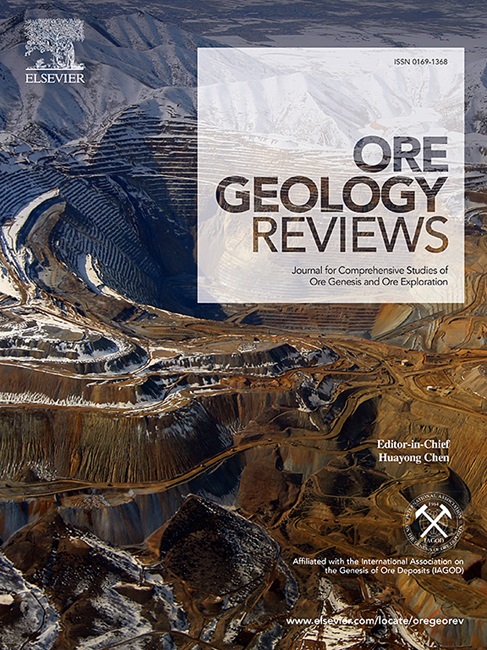Geology of the Bisie wood tin (cassiterite) deposit and its host rocks, North Kivu Province, DR Congo
IF 3.2
2区 地球科学
Q1 GEOLOGY
引用次数: 0
Abstract
The Bisie Tin Mine, located in the Mesoproterozoic Kivu Belt in the Democratic Republic of Congo, is the world’s highest-grade tin operation with an average grade of 4.5 % Sn. In this study we provide a geological description of the deposit and its surrounding mine license area and present U-Pb geochronological data for an adjacent granite massif.
The metasedimentary host rocks of the Bisie Tin Mine comprise: (1) Mica schists and intercalated mafic and felsic intrusive and extrusive rocks; (2) a “metasedimentary unit” of clastics, containing a mafic tuff component and (3) carbonaceous shale. The metamorphic grade decreases away from the granite massif and upwards in the stratigraphic sequence. The mica schist displays a peak metamorphic assemblage of staurolite, garnet and biotite. overgrowing a muscovite-dominated foliation.
Multiple stages of magmatism occurred in the granite massif, including an undated biotite syenogranite as the most voluminous phase. Further sub-intrusions include alkaline granites, syenites and monzogranites. A marginal monzogranite yields 1271–1273 Ma U-Pb zircon ages, indicating that felsic magmatism was partially synchronous with the development of surrounding metasediments. A previous study reported a granite age of 1518 ± 40 Ma, pre-dating the onset of the Kibaran orogeny and gneissic rocks within the granite massif with a maximum age of around 1000 Ma, contemporaneous with the G4 granite stage. The granite massif likely formed in an extensional environment (metamorphic core complex) exhuming pre-Kibaran rocks, and was subsequently intruded by Kibaran granite phases.
The Bisie deposit is located in mica schist about 500 m from the granite contact in the northern project area. Tin mineralisation is hosted in a steeply east-dipping shear zone oriented parallel to the contact with the granite massif. Along the shear zone, an alteration halo is developed for >14 km – manifested in the replacement of metamorphic porphyroblasts by muscovite (± chlorite) and development of Sn anomalies in the soil cover.
Tin mineralisation occurs as up to ∼1 m wide veins of botryoidal cassiterite (so-called wood tin). The veins are hosted within an up to ∼25 m wide alteration envelope of chlorite (± actinolite) schist. High-grade ore shoots plunge at intermediate angle to the north and contain folded veins, absent in low grade zones, as well as N(NW)-trending veins paralleling the shear zone. Continued deformation in the shear zone caused cassiterite veins to be strongly boudinaged and brecciated. Cassiterite previously dated to ∼1068–1026 Ma, formed contemporaneously with the G4 granite stage. Quartz veining and precipitation of pyrite, chalcopyrite, arsenopyrite (± sphalerite and galena) are associated with later NW-, NNW- and E-W-trending faults that dissect the tin-mineralised shear zone. NW-trending faults segmented the Bisie deposit into the Mpama North and South ore bodies. Multiple phases of normal and strike-slip movement reactivated these faults..
Massive sulphide lenses with an inferred syn-sedimentary origin occur proximal to the tin mineralisation in the Mpama South area.

求助全文
约1分钟内获得全文
求助全文
来源期刊

Ore Geology Reviews
地学-地质学
CiteScore
6.50
自引率
27.30%
发文量
546
审稿时长
22.9 weeks
期刊介绍:
Ore Geology Reviews aims to familiarize all earth scientists with recent advances in a number of interconnected disciplines related to the study of, and search for, ore deposits. The reviews range from brief to longer contributions, but the journal preferentially publishes manuscripts that fill the niche between the commonly shorter journal articles and the comprehensive book coverages, and thus has a special appeal to many authors and readers.
 求助内容:
求助内容: 应助结果提醒方式:
应助结果提醒方式:


